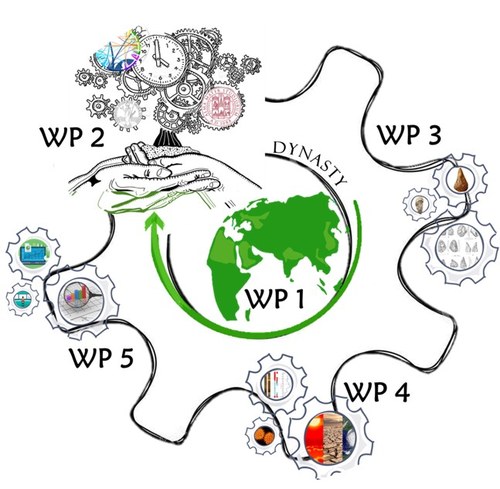Work Packages
Radiocarbon, Neanderthals, Paleomagnetism, Blake Event, Climate change , Middle and Upper Palaeolithic, Human Evolution

WP1: FIELDWORKS
Fieldwork in some key geological and archaeological sites in Southern Poland and Hungary is critical to retrieve high-resolution data on paleoclimate, paleoecology, chronology, and archaeology for the period between MIS 5e and MIS 3. In fact, detailed multidisciplinary analysis on the selected loess/paleosol sections and archaeological sites are still missing.
WP2: CHRONOLOGICAL ASSESSMENT OF THE GEOLOGICAL SECTIONS AND ARCHAEOLOGICAL SITES
Detailed chronologies of the sedimentary sequences and archaeological sites will be achieved by using the following methodologies:
-RADIOCARBON (14C)
-PALEOMAGNETISM
-Optically Stimulated Luminescence (OSL)
WP3: TECHNOLOGICAL ANALYSIS OF THE LITHIC ASSEMBLAGES
The technological analysis of the lithic assemblages and the statistical comparison between Polish and Hungarian sites is crucial for comprehending the dynamics of mobility and demographic structure of Neanderthals.
Firstly, the lithic assemblages will be macroscopically discriminated by the different raw materials units (RMU) according to macroscopic characteristics, including color, grain size, and cortex structure. Successively, the lithic collections will be analyzed using the chaîne opératoire concept. This methodology defines the reconstruction of the various processes of flake production from the procurement of raw materials through manufacture and utilization phases until the final discard.
In this WP, the core reduction strategies will be identified for each site.
Then, the different metric (e.g. weight, length, width, thickness) and qualitative (e.g., number of dorsal negatives, types of platforms) variables of the lithic items ≥ 1 cm will be recorded in a database. Bifacial tools and cores will be scanned with a 3D scanner.
WP4: PALEOCLIMATIC & PALEOECOLOGICAL ANALYSIS
Regional paleoclimatic variability will be reconstructed using integrated lithologic, rock-magnetic, geochemical, and pollen records.
These parameters will provide high-resolution numerical experimental records for further processing, interpretation, and integration with the lithologic and pollen records for detailed climatic reconstructions. Micropedology will support in discriminating among sediments and paleosols and will allow reconstructing sedimentary and post-sedimentary (pedogenetic and diagenetic) processes that occurred in each sequence. This method will provide insights into climate-driven environmental changes. The investigation on thin sections will also inform on the occurrence of indicators of paleosurfaces' human occupation as much as to highlight post-sedimentary disturbances. Bulk sediments will be analyzed for the content of total and organic C and N and stable isotopes (δ13C and δ15N) with an elemental analyzer (EA) couple with an isotope ratio mass spectrometer (IRMS). This will enable us to understand the variation of soil metabolism which is governed by landscape-atmospheric feedback processes.
WP5: SYNTHESIS
The cross-referencing of the data retrieved from the paleoclimatic, paleoecological, chronological, and technological analysis is crucial for understanding the dynamics of mobility and extinction in Neanderthals during the Late Middle Paleolithic in Central Europe. All these data will be crossed to create different models. The different models' codes will be added in the supplementary materials of the open-access publications to promote research transparency and replicability.
•AGENT-BASED MODEL: The agent-based is a computational model for simulating the interactions of autonomous agents to understand their effects on a determined system.
This new model will allow testing diachronically different hypotheses on the set of causes that promoted the resilience, expansion, or extinction of Neanderthals in Central Europe during the Late Middle Paleolithic.
•BAYESIAN MODEL: To securely evaluate the relationship between samples dated and their archaeological context, the Bayesian statistics approach is the way to take. In fact, Bayesian techniques combine the chronometric information (14C ages and OSL) with the archaeological knowledge or 'prior' information (e.g., stratigraphy).
This allows much finer chronologies to be built for the site in question.
COMMUNICATION & DISSEMINATION OF THE PROJECT
Research results generated in all five WPs will be turned into scholarly articles, to be published open-access in international, peer-reviewed journals as soon as possible to facilitate the greatest possible scientific impact. The research results will be shared with colleagues at international conferences.
The organization on an annual basis of research seminars held by internal and external speakers invited by the host partner institutions, open to the public and aiming to increase interest and bring new perspectives to the study of Neanderthal mobility and climate change by addressing both other researchers and the non-specialist public. The dissemination of the project results will also include participation in the Science Week and the Open Doors of UniBO and UniMI, allowing the public to interact with the contents and the scientific processes derived from the research project. A symposium inviting the prominent scholars of the topic will be organized to establish a network of scientists from different countries, including researchers from the host institution involved in the DYNASTY project, to collaborate on different topics, including dispersal patterns, paleoclimate, and cultural transmission.